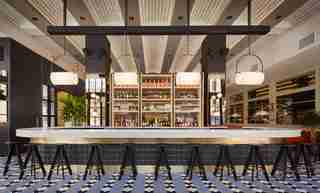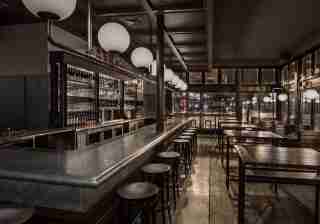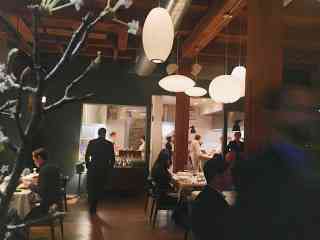It's no secret that the sprawling city of Chicago is already beloved for its skyline and architectural savvy. Now, a crop of unpretentious new venues highlight a warm, industrial swagger with a touch of pared-down midcentury style. Below, we share our favorite new Windy City debuts.

Proxi
This month, a midcentury American brasserie by James Beard Award–winning design firm Meyer Davis opens its doors. The indigenous architectural details are still intact: soaring ceilings, austere columns with hand-glazed blue tiles, and blackened steel strapping; there are also big-name furniture pieces from Tom Dixon, Hem, and Stellar Works. A central stone-top bar sits just opposite a chef’s table with Noir St. Laurent marble, affording prime views of chef Andrew Zimmerman’s open kitchen. 565 West Randolph St.; proxichicagoom

Publican Anker
Located on a happening corner in Wicker Park and designed by James Beard Award–winning Thomas Schlesser, the newest offering from the hip One Off Hospitality Group (behind the swanky James Beard cocktail mecca Violet Hour and sophisticated, small-plate avec ) is this savvy, updated beer hall–esque offering of intimate booths, rows of soft yellow bulbous light fixtures, high-top tables, and roomy communal seating. Floor-to-ceiling windows grant stellar people-watching, and patrons can enjoy a spread of raw and wood-roasted seafood, wines by the glass, and, of course, classic vinyl on the speakers. 1576 N. Milwaukee Ave.; publicanankerom

Oriole
Diners arrive by way of a speakeasy-style freight elevator and are ushered into an intimate yet familiar 28-seat dining room of bare brick walls, soaring ceilings, exposed timber columns, custom banquettes with midcentury legs, and a dreamy cluster of Nelson pendants that appear to be floating. Instead of enlisting a traditional firm, the owners designed the space to be much like their home, a soothing mix of branches, potted plants, and small bud vases. Of course, the focus is on the refined tasting menu, artistically plated from an open kitchen, by two-Michelin-star–winning chef Noah Sandoval. 661 W. Walnut St.; oriolechicagoom
The Robey
In Wicker Park, the pie-shaped Art Deco building from Mexico City–based Grupo Hábito features 69 rooms dressed in earthy minimalist tones, frosted glass, terrazzo floors, and Amish-made beds topped with soft Woolrich blankets. Upstairs, the intimate and dimly lit, glass-encased rooftop lounge Up and Up is dotted with low-slung, high-back sofas and shakes seasonal cocktails to the beat of glorious, panoramic skyline views. 2018 W. North Ave.; therobeom
Roister
From the famed Alinea Group, the rustic, boisterous Roister, which blurs the distinction between dining room and kitchen, brings together a meld of dark wood and brick. Designed by James Geier of 555 International, the front dining room walls feature a custom plaster finish and pop with large abstract black-and-white pieces by Chicago-based Adam Siegel. Perhaps the best seats in the house are the 16 stools sandwiched in the middle, where patrons can watch the open kitchen flames and nosh on the restaurant’s signature whole chicken dish, brined for 24 hours in chamomile sweet tea. 951 W. Fulton Market; roisterrestauranom
Giant
Despite its name, Giant is a relatively narrow 44-seat venue in Logan Square, a bright mix of the work of local artists and fabricators. Flanking one side of the restaurant, painted white brick meets canary yellow–and–gray fabric patchwork banquettes with artwork courtesy of chef Jason Vincent’s friend, Nora Murphy Mills. Handmade wood tables provide a resting place for menus to hang on hooks, and a cozy kitchen counter gives diners a front seat to the kitchen action. Coming soon: an alfresco summer patio. 3209 W. Armitage Ave.; giantrestauranom
